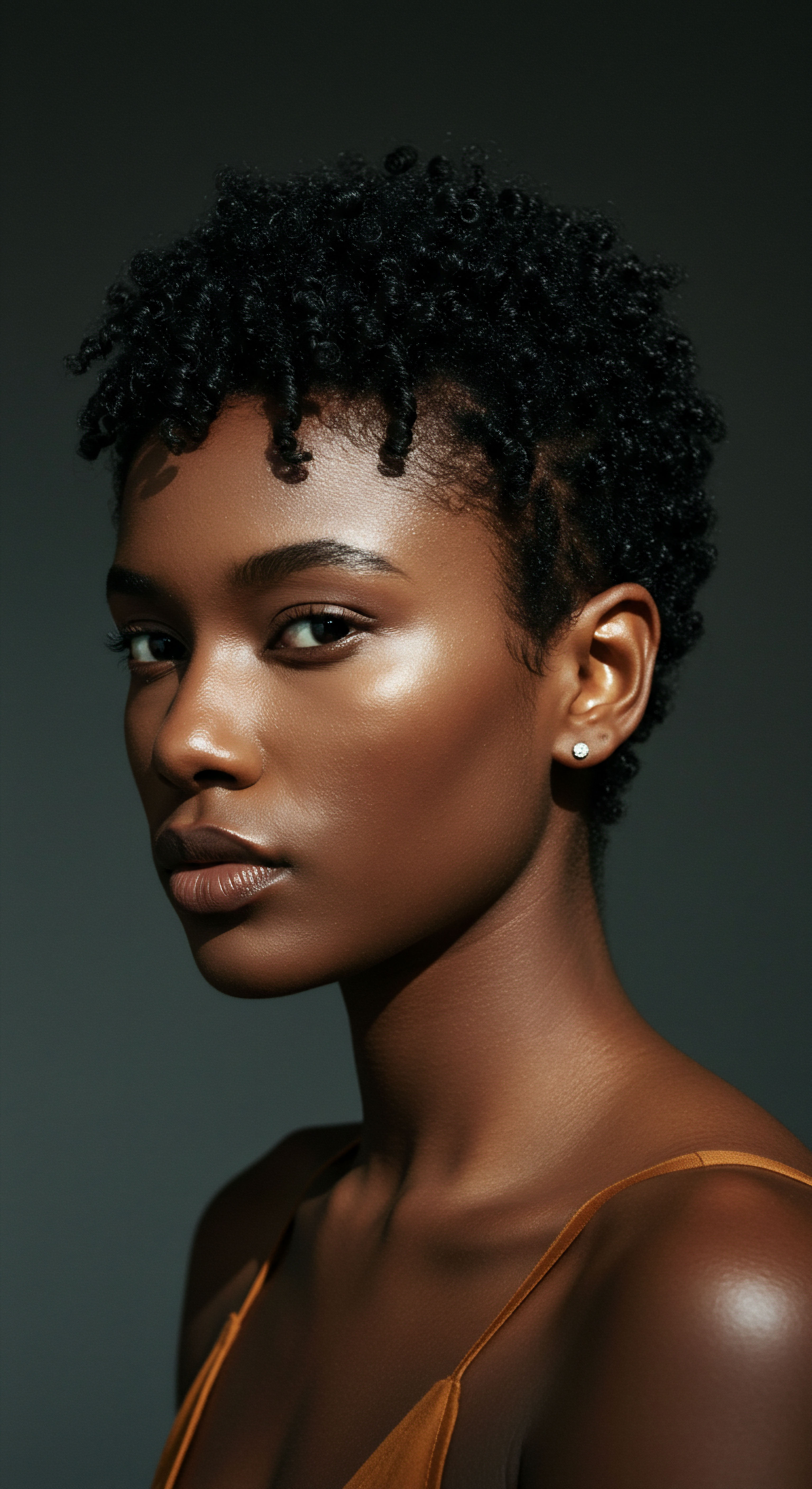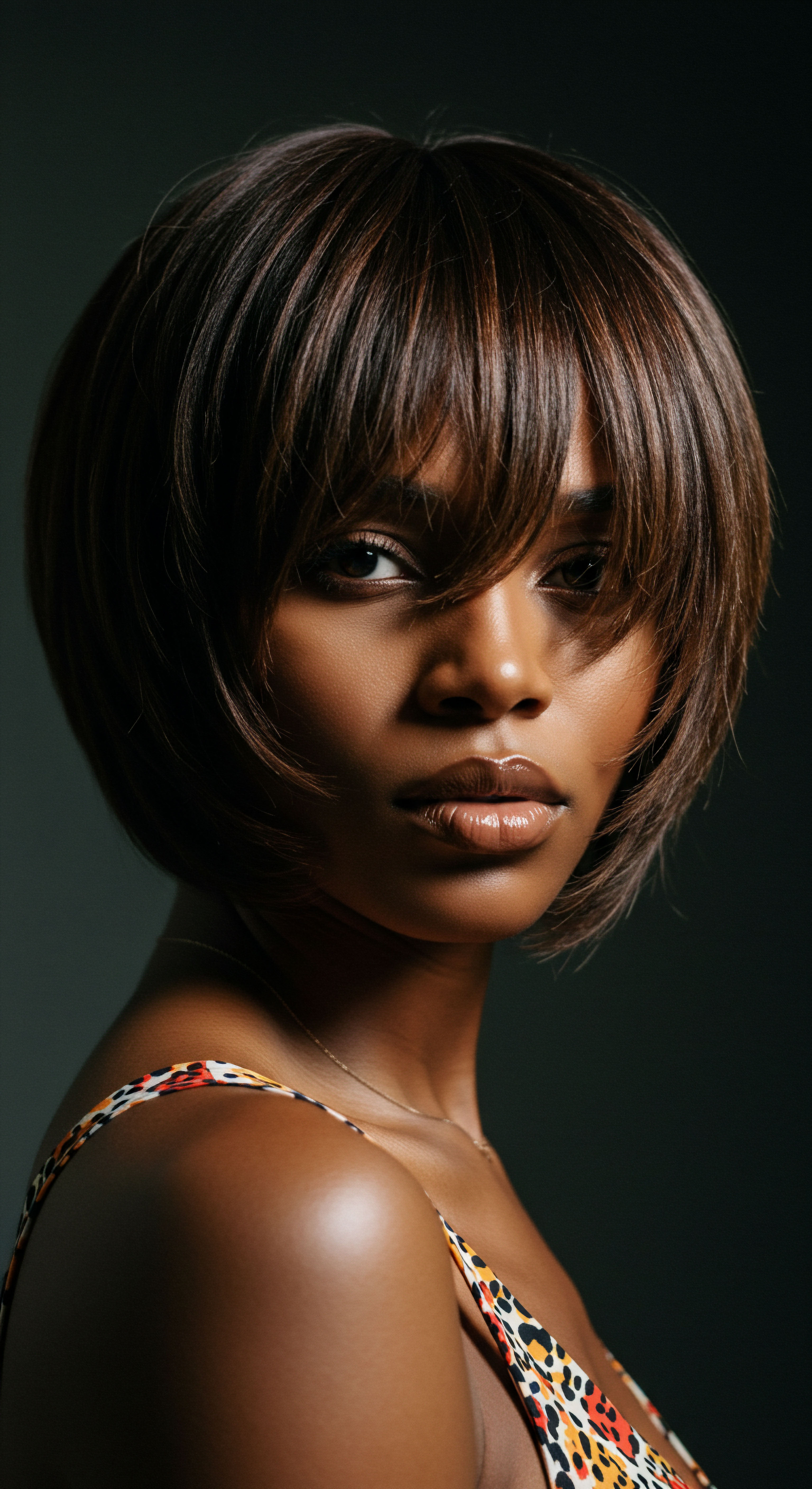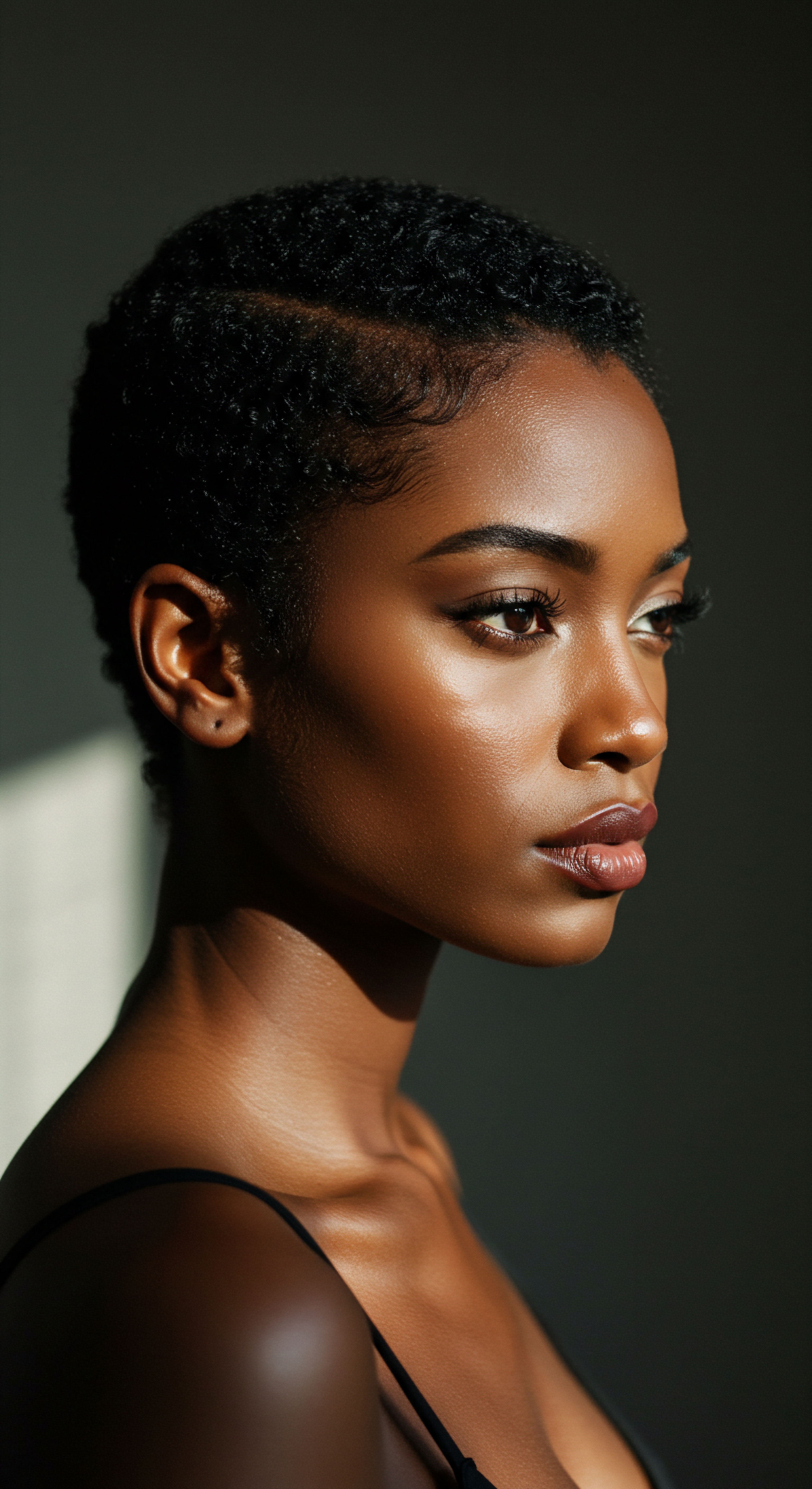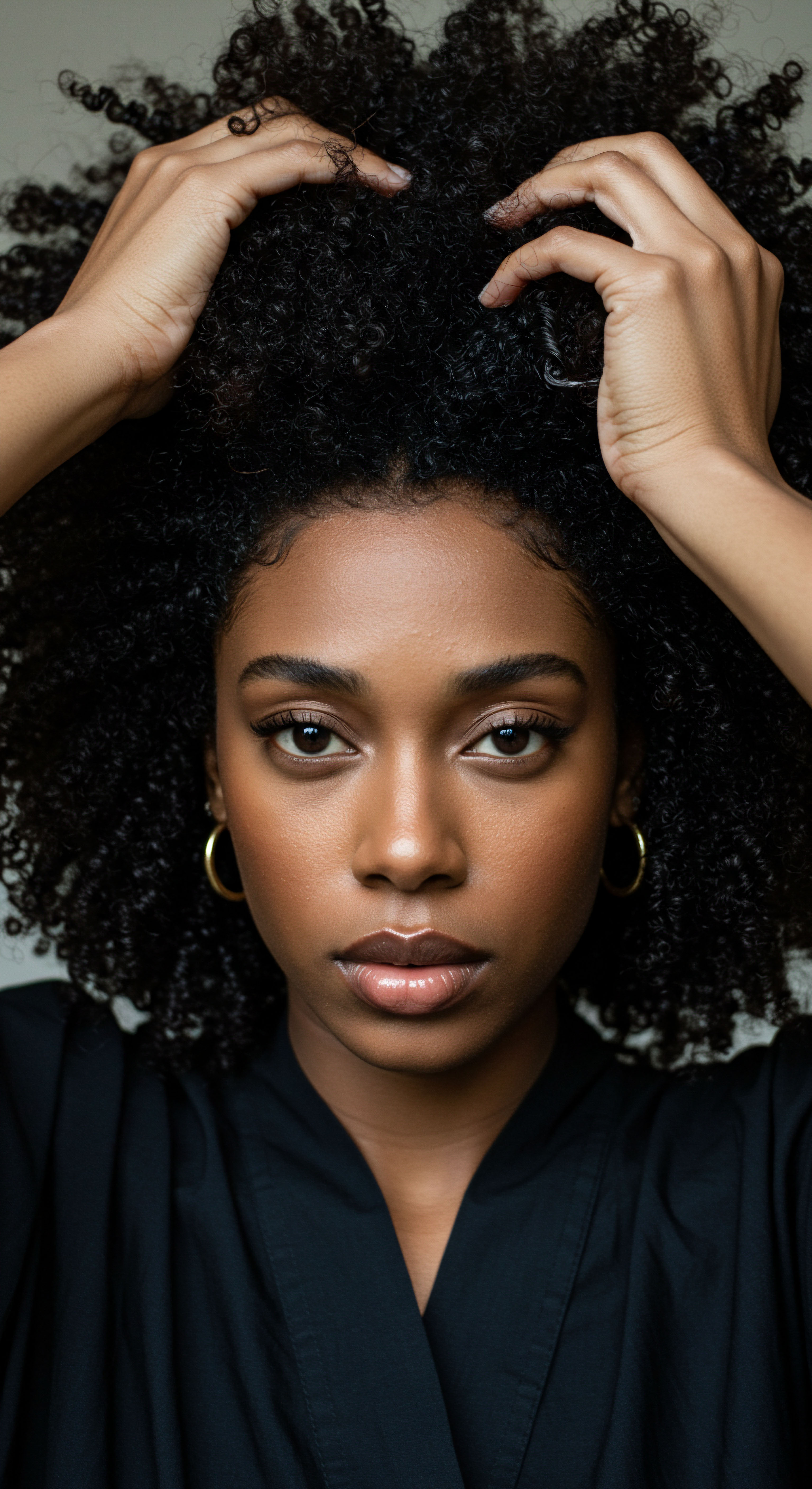
Roots
There exists a quiet wisdom whispered through generations, a knowing that certain rhythms of life underpin our very being, even down to the individual strands that crown us. Long before the advent of modern science, an intuitive understanding of restoration guided daily choices, a recognition that the body, when granted its rightful reprieve, could mend and renew. This elemental truth, often obscured by the clamor of contemporary life, speaks directly to the delicate balance within our hair.
We often fixate on external applications, the lotions and potions, yet overlook the profound internal orchestrations that dictate hair’s very vitality. The quiet hours of slumber, far from being mere voids, are a crucible of cellular work, a period when the scalp’s intricate ecosystem performs its most diligent repair.
Our hair, particularly textured hair with its beautiful coils and intricate patterns, carries a unique legacy, often demanding a deeper, more empathetic understanding of its needs. Its strength, its resilience, its ability to spring forth with vigor, stems not only from what we apply but also from the unseen processes occurring within. The journey of a single hair strand begins beneath the surface, deep within the hair follicle, a microscopic marvel of biological engineering.
This follicle, nestled within the scalp, is a dynamic mini-organ, constantly undergoing cycles of growth, transition, and rest. Its sustained health is paramount for the production of strong, vibrant hair.
The true vitality of our hair finds its genesis in the unseen, restorative rhythms woven into the fabric of our daily existence.

The Hair Follicle A Microscopic Wonder
Each hair on our head emerges from its own dedicated follicle, a tiny, yet incredibly active structure. Within this follicle, cells divide and multiply at a remarkable rate, pushing upwards to form the hair shaft we see. This rapid cellular activity requires substantial energy and a steady supply of nutrients.
When the body is engaged in constant activity, whether physical or mental, its resources are diverted, sometimes away from less critical, though aesthetically important, functions like robust hair growth. The very architecture of the hair strand, its integrity and inherent strength, are fundamentally determined at this formative stage within the follicle.
- Hair Follicle ❉ The tiny organ responsible for producing hair.
- Hair Shaft ❉ The visible part of the hair, composed primarily of keratin.
- Dermal Papilla ❉ A cluster of cells at the base of the follicle that provides nutrients to the growing hair.

What Are the Cycles of Hair Growth?
Hair growth unfolds in distinct phases, a biological cadence that governs the life of each strand. Understanding these phases helps clarify how systemic factors, such as consistent rest, play a role.
- Anagen Phase ❉ This is the active growth phase, where hair cells divide rapidly, pushing the hair shaft upwards. For scalp hair, this phase can last anywhere from two to seven years, largely determining the maximum length a hair can achieve.
- Catagen Phase ❉ A brief transitional phase, lasting only a few weeks, where hair growth stops, and the outer root sheath shrinks and detaches from the dermal papilla.
- Telogen Phase ❉ The resting phase. During this time, the hair remains in the follicle but is not actively growing. This phase typically lasts around three months. At the end of the telogen phase, the old hair sheds, and a new anagen hair begins to grow from the same follicle.
The duration and healthy progression through these cycles are susceptible to internal conditions. Disruptions, often linked to physiological stress, can prematurely shift hairs into the resting or shedding phases, leading to thinner, weaker strands or increased hair fall. The quality of our rest directly influences the body’s ability to maintain these delicate cycles without interruption.

Ritual
Stepping from the foundational science, we arrive at the practical realm, where the quiet wisdom of rest finds its tangible expression in our daily and nightly practices. We often seek elaborate regimens for hair care, meticulously selecting products and techniques, yet sometimes overlook the most profound and accessible act of care ❉ allowing the body, and by extension, the hair, its essential time for restoration. The rituals surrounding sleep, from ancient traditions of preparing for slumber to modern understandings of sleep hygiene, carry a silent power, influencing not just our general well-being but the very fabric of our hair.
Consider the transition from the bustling demands of the day to the tranquil stillness of night. This shift is not merely about physical cessation of activity; it is a profound physiological recalibration. During these hours, the body orchestrates a symphony of repair and regeneration, processes that are directly tied to the integrity and strength of our hair. The seemingly simple act of consistent rest becomes a cornerstone of a holistic hair care practice, a ritual that quietly yet powerfully underpins all other efforts.

Nighttime Sanctuary Protecting Your Strands
The night hours are particularly significant for hair health. As we rest, the body’s metabolic processes slow, allowing energy to be redirected towards repair and synthesis. This includes the intricate work happening within the scalp and hair follicles.
Proper blood flow to the scalp, vital for nutrient delivery to the hair bulb, is often optimized during sleep, especially when stress levels are reduced. Furthermore, the friction and manipulation hair experiences throughout the day are largely absent during periods of stillness, reducing mechanical stress on delicate strands.
| Benefit Area Cellular Repair |
| Description The body directs energy to mend and rebuild cells, including those in the hair follicles and scalp. |
| Benefit Area Nutrient Delivery |
| Description Improved circulation to the scalp ensures a steady supply of vitamins and minerals to the hair bulb. |
| Benefit Area Reduced Friction |
| Description Less mechanical stress on hair strands compared to daytime activities, minimizing breakage. |
| Benefit Area Hormone Balance |
| Description Proper sleep helps regulate hormones, including those influencing hair growth cycles. |
| Benefit Area A calm, restorative sleep environment directly supports hair's inherent ability to fortify itself. |

How Do Bonnets and Silk Pillowcases Aid Nighttime Care?
Beyond the internal benefits of rest, external practices during sleep also contribute significantly to hair strength. For textured hair, which is often more prone to dryness and mechanical damage, the choice of sleep accessory holds particular importance.
Using a Silk or Satin Bonnet or pillowcase creates a gentle, low-friction surface for hair to rest upon. Cotton, a common pillowcase material, has a rougher surface that can snag and pull at hair strands, leading to frizz, tangles, and ultimately, breakage. Cotton also absorbs moisture, potentially drawing essential hydration from hair and leaving it drier.
Silk and satin, by contrast, allow hair to glide smoothly, preserving its delicate structure and moisture balance. This simple ritual, adopted consistently, offers a protective shield against the nightly wear and tear that can silently diminish hair strength over time.
Adopting protective sleep rituals, such as silk bonnets, offers a tangible shield against the unseen nightly wear that can diminish hair’s inherent resilience.

Establishing a Serene Pre-Sleep Routine
The preparation for rest itself can become a ritual that signals to the body and mind that it is time to unwind. This isn’t about rigid rules, but about creating a calming transition. Simple actions like a warm bath, gentle stretching, or reading a book can help quiet the nervous system.
For hair, this might involve a light scalp massage to stimulate circulation, or gently detangling strands before securing them for the night. These deliberate, calming steps contribute to the overall quality of rest, which in turn supports the body’s restorative processes, including those that benefit hair vitality.

Relay
Venturing deeper, we consider the intricate interplay of biological and systemic factors that bridge the quietude of rest with the tangible strength of our hair. The query concerning consistent rest and hair strength is not a simple linear equation; rather, it beckons us to consider a complex network of internal communications, where the body’s state of repose or agitation ripples through its various systems, ultimately influencing the very cells that shape our strands. Here, the lens widens to encompass the profound dialogue between our nervous system, our hormonal balance, and the hair follicle itself.
The modern world often extols constant productivity, sometimes at the expense of adequate rest. This perpetual state of ‘on’ can inadvertently activate physiological responses designed for acute stress, not chronic endurance. When the body perceives ongoing demands without sufficient periods of recuperation, it triggers a cascade of hormonal shifts.
These shifts, particularly involving stress hormones, can have a direct, measurable impact on the delicate machinery of hair growth. Understanding this intricate connection allows for a more comprehensive approach to hair health, one that transcends superficial treatments.

Does Prolonged Stress Impact Hair Growth Cycles?
The connection between prolonged stress and hair health is well-documented, and consistent rest serves as a primary antidote to chronic stress. When the body experiences stress, whether physical or psychological, it releases hormones like Cortisol. While cortisol is vital for short-term stress responses, chronically elevated levels can disrupt numerous bodily functions, including the hair growth cycle.
Research indicates that high levels of cortisol can prematurely push hair follicles from the active growth (anagen) phase into the resting (telogen) phase. This phenomenon, often observed as Telogen Effluvium, results in increased hair shedding and a noticeable thinning of the hair over time. A study by Arck et al. (2006) titled “Stress and the Hair Follicle” published in PLOS Medicine, elucidates how stress hormones directly impact the hair follicle’s immune privilege and cycling.
They highlight that chronic stress can induce a neuroendocrine-immune imbalance at the hair follicle level, leading to an early cessation of the anagen phase and premature entry into catagen, followed by telogen. This scientific understanding underscores that the body’s internal environment, heavily influenced by stress and its counterpoint, rest, directly dictates the longevity and vigor of each hair strand.
Therefore, consistent, restorative rest is not merely about feeling refreshed; it is a critical physiological intervention that helps regulate cortisol levels, allowing the hair follicles to remain in their active growth phase for longer periods. This sustained anagen phase is a fundamental prerequisite for producing strong, long, and resilient hair.
The intricate interplay of rest, stress hormones, and hair follicle behavior shapes the very destiny of each strand.

The Circadian Rhythm and Hair Health
Our bodies operate on a roughly 24-hour cycle known as the Circadian Rhythm, which regulates sleep-wake patterns, hormone release, and numerous other physiological processes. Hair follicles themselves exhibit circadian rhythms, meaning their cellular activity and growth rates fluctuate throughout the day and night. Disruptions to this natural rhythm, such as those caused by irregular sleep patterns, shift work, or chronic sleep deprivation, can send confusing signals to the hair follicles.
When the circadian rhythm is out of sync, the optimal timing for cellular repair and nutrient absorption within the hair follicle can be compromised. This can lead to less efficient protein synthesis, weaker hair shaft formation, and a general decline in hair vitality. The body’s ability to repair DNA damage, produce necessary proteins, and maintain cellular integrity is largely dependent on these internal clocks functioning harmoniously. Consistent rest, particularly sleep that aligns with our natural circadian cycle, allows these processes to occur unimpeded, thereby supporting the foundational strength of the hair.
| Disruption Area Hormonal Imbalance |
| Hair Health Consequence Disrupted cortisol and melatonin cycles affecting hair growth. |
| Disruption Area Cellular Repair Impairment |
| Hair Health Consequence Reduced efficiency of DNA repair and protein synthesis in follicles. |
| Disruption Area Nutrient Uptake Issues |
| Hair Health Consequence Suboptimal timing for delivery and absorption of vital hair nutrients. |
| Disruption Area Accelerated Aging |
| Hair Health Consequence Increased oxidative stress contributing to premature hair weakening. |
| Disruption Area Maintaining a steady sleep schedule fortifies hair's inherent resilience against environmental and internal stressors. |

Can Melatonin Influence Hair Follicle Activity?
Melatonin, often called the “sleep hormone,” is primarily known for regulating sleep-wake cycles. However, emerging research suggests it may also play a direct role in hair follicle biology. While the full extent of its influence is still under investigation, some studies have explored melatonin’s potential as a hair growth stimulant or its role in protecting hair follicles from damage. For instance, some topical applications of melatonin have shown promise in promoting hair growth in certain types of alopecia.
This connection highlights that the chemical environment during rest, orchestrated by hormones like melatonin, is not passive but actively engaged in processes that affect hair. A body that consistently achieves restorative sleep produces and regulates these vital hormones optimally, creating an internal climate conducive to robust hair growth and maintenance. The delicate balance of these internal signals, supported by adequate rest, ultimately translates into hair that is not only aesthetically pleasing but also structurally sound.

Reflection
The journey through the intricate world of hair strength and its connection to consistent rest reveals a profound truth ❉ our hair, much like the delicate balance of our entire being, thrives when it is given the gift of stillness and restoration. It is a quiet reminder that the most impactful acts of care often begin not with elaborate external applications, but with a deep reverence for the body’s inherent wisdom and its cyclical needs. The strength we seek in each strand is not merely a product of genetics or topical treatments; it is a living testament to the harmony within, a visible manifestation of a body allowed to mend, renew, and flourish in its quiet moments of repose. This understanding invites us to approach hair care not as a superficial pursuit, but as an extension of holistic well-being, where the quiet moments of rest become as vital as any product on our shelf.

References
- Arck, P. C. Handjiski, B. Peters, E. M. J. Peter, A. S. Klapp, B. F. & Paus, R. (2006). Stress and the Hair Follicle. PLOS Medicine, 3(8), e398.
- Fischer, T. W. Twelbeck, S. & Elsner, P. (2000). Melatonin inhibits hair growth in C57BL/6 mice. Journal of Investigative Dermatology, 115(3), 441-444.
- Hardy, M. H. (1992). The Secret Life of the Hair Follicle. Trends in Genetics, 8(2), 55-60.
- Oh, S. H. et al. (2013). Effects of Sleep Deprivation on Human Hair Follicle Cycle. Korean Journal of Dermatology, 51(9), 705-710.
- Paus, R. & Cotsarelis, G. (1999). The Biology of Hair Follicles. The New England Journal of Medicine, 341(7), 491-497.
- Randall, V. A. (2008). Hormonal regulation of hair growth ❉ an overview. Hair Loss Disorders, 10, 1-13.
- Rebora, A. (2004). Telogen effluvium ❉ a review of the current data and a proposal for its classification. Clinical and Experimental Dermatology, 29(6), 609-612.